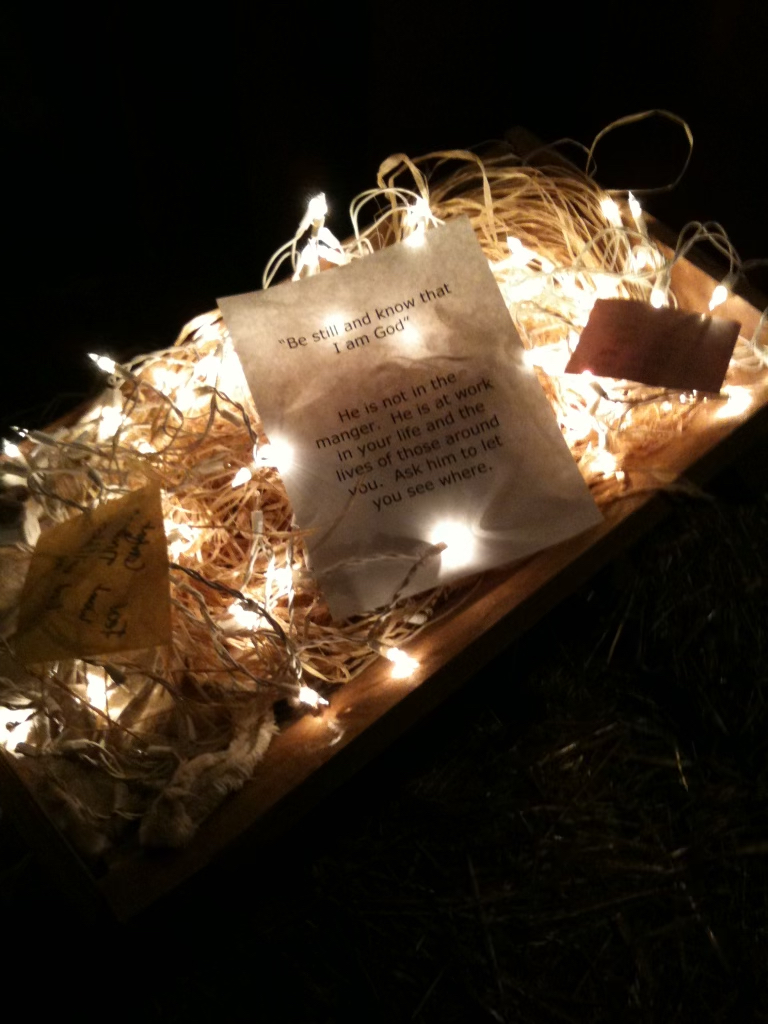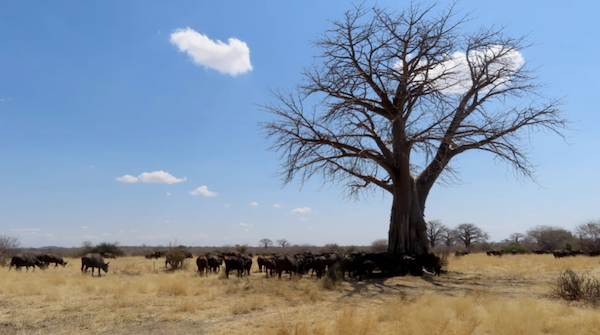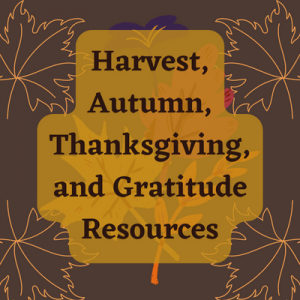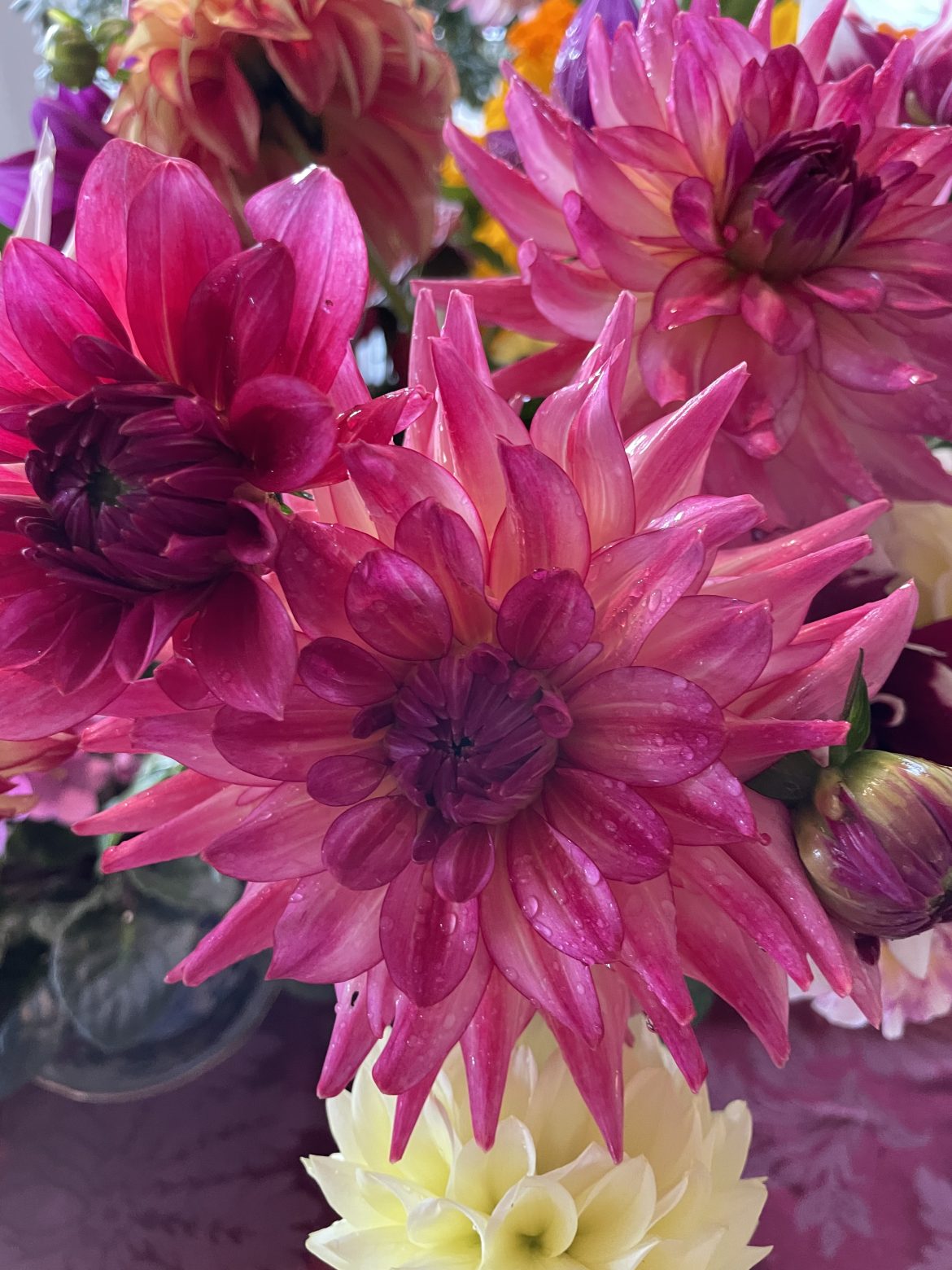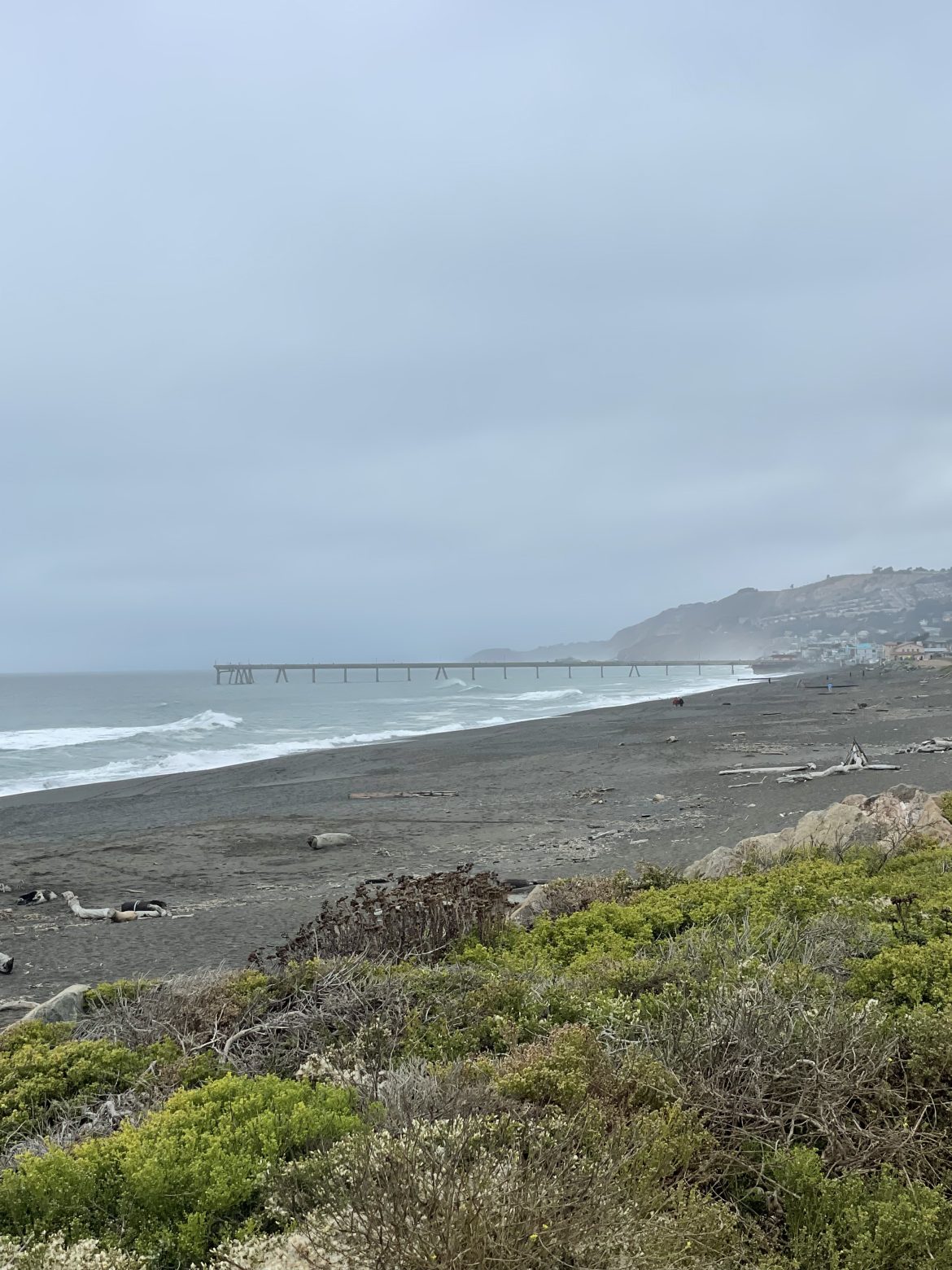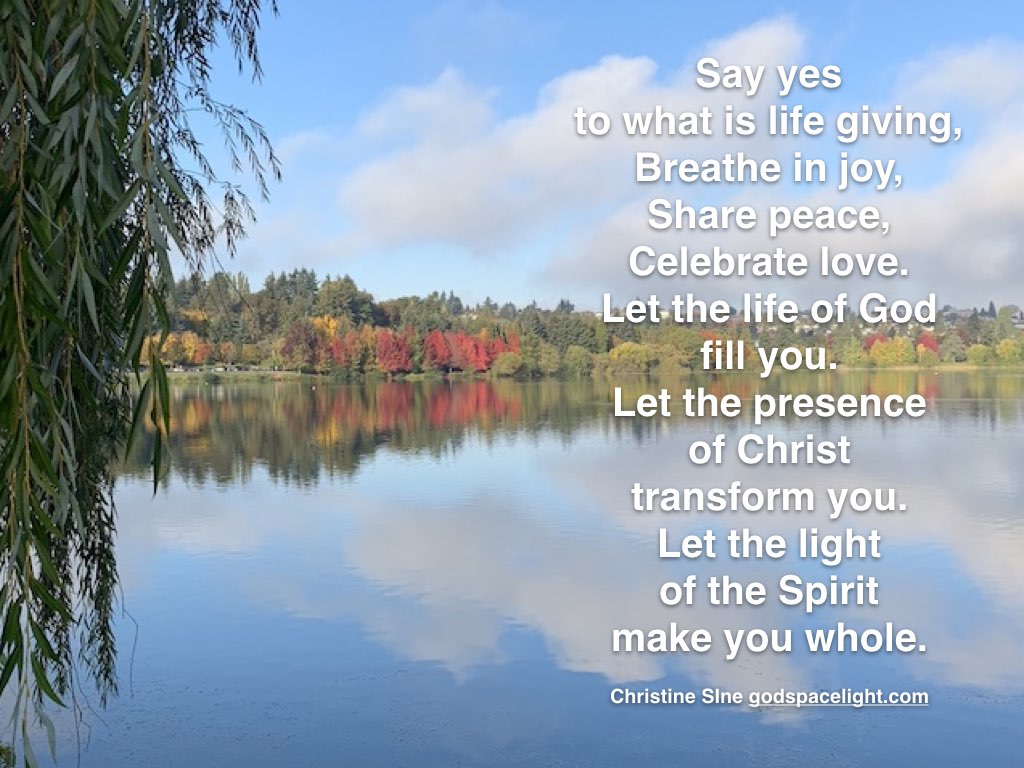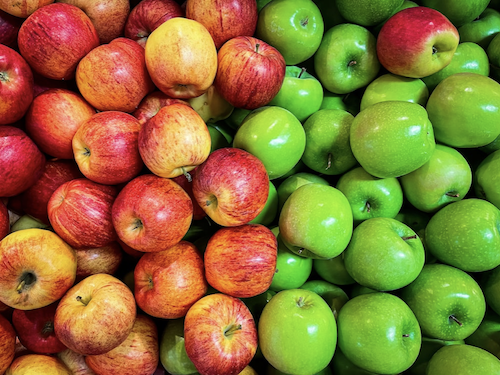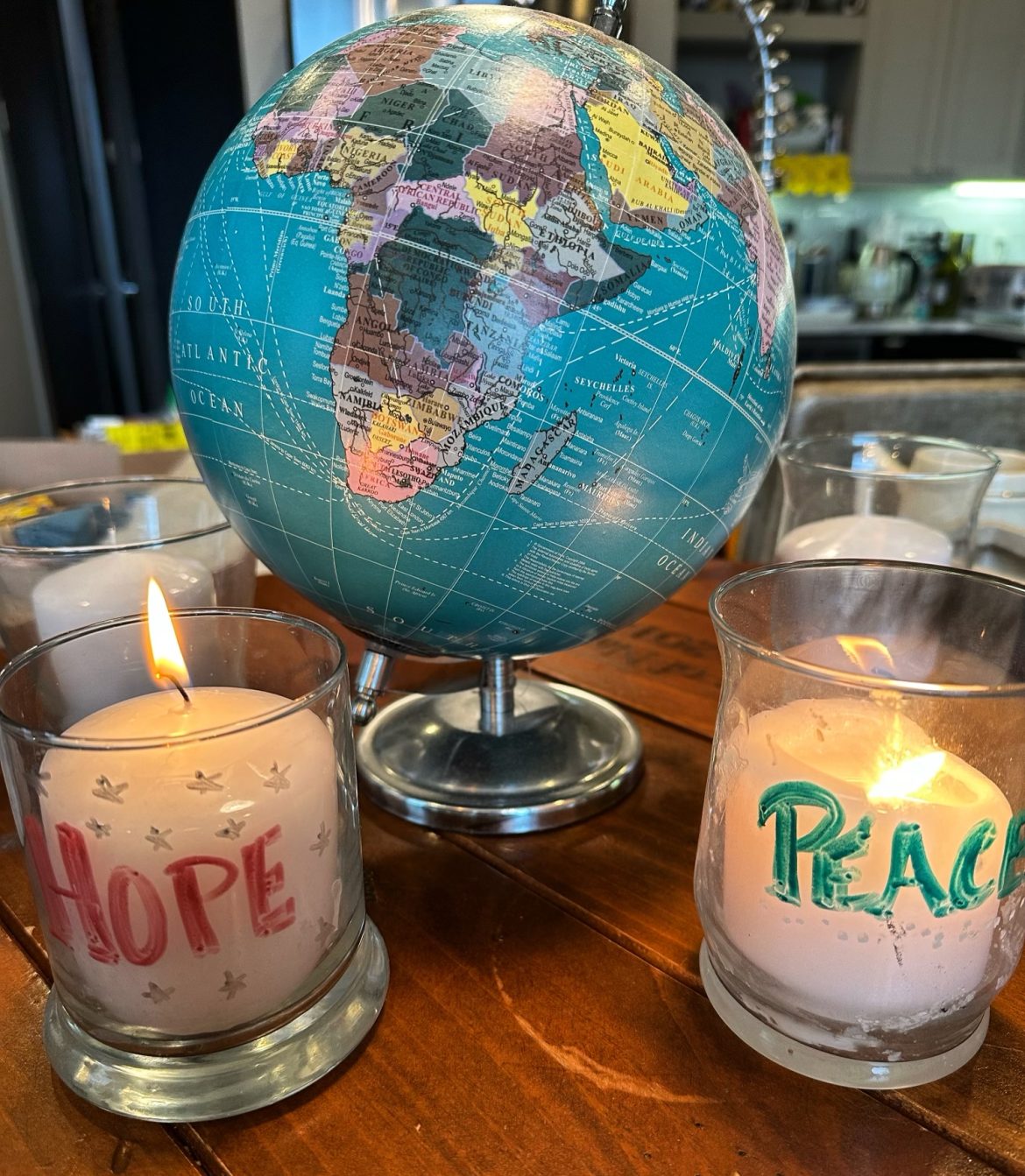As many of you know, I tend to feel like the calendar just races by me! I saw my first Christmas tree this week in the window of a neighbor. While his porch and front door are decorated for Fall/Autumn. He now has his Christmas tree lit up in his window. I saw a blurb on Instagram that said that people who decorate early are happier….hum. I’m not sure that’s true. At least not for me. I definitely take decorating for the holidays slowly and I like to enjoy each season as it comes. I have been enjoying the colors of the leaves and the pumpkins. I just wish that it wasn’t so hot here in Nashville so it would actually feel like Fall/Autumn, but maybe next week. But as we turn the calendar page, I’ve started thinking about Advent. Celtic Advent starts in mid November. November 16th. This gives us forty days to prepare our hearts for the birth of Jesus.
I think this year, with all the strife, suffering and violence, I need ADVENT more than ever. I need that slow waiting. Being still and walking slowly towards Christmas.
A group of youth leaders were in Nashville this week and I had the opportunity to set up some Advent Prayer stations to give them some ideas to take home with them to use this December. These are from the Sacred Space Kit called ADVENT WAITING. The one with the manger hit me hard.
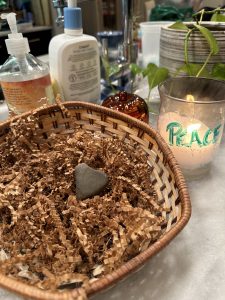
kitchen counter manger
I invite you to create or find a manger ..it can be a basket filled with straw or a wooden bowl from your kitchen. The concept is to have a physical reminder of the place where Mary laid Jesus.
Consider these questions:
Who are you waiting for?
What are you waiting for as you move towards Christmas?
What do you need from Jesus?
Is your manger dusty, filled with spider webs and old straw?
Or, you might have never had a manger.
Do you need to find a manger or build one this year in preparation for the coming of the King?
Can you imagine your heart as a manger for Jesus?
WRITE on a piece of wrapping paper: your name and what you need this ADVENT.
PUT YOUR NAME & PRAYER IN THE MANGER… TELL JESUS WHAT YOU NEED.
I am waiting for peace
I am praying for peace and cease fire and for compassion AND THE END OF GUN VIOLENCE.
I desperately need the Prince of Peace to be central in my heart and mind. I have totally felt the cobwebs in the manger of my heart in recent days!
I am putting the manger on the kitchen counter to remind me to keep my heart open and allow my heart to be a manger this year. A place of birthing and safety, a home for Jesus. AMEN
You can purchase an ADVENT WAITING sacred space kit at freerangeworship.com
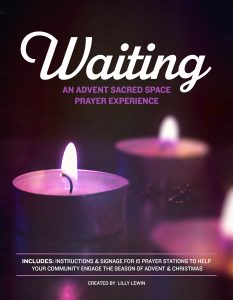
Take some time to consider what you’d like your Advent season to be like this year. Do you want to read a book? Rest? Ask Jesus to show you what you need this Advent and take time to prepare Him Room!
by Barbie Perks
Yesterday I spent a good amount of time thinking on baobab trees as we were driven through the Ruaha National Park in Tanzania. It is the dry, hot and dusty season and it was 35ºC in the shade. There wasn’t a single baobab with leaves or fruit on it. It only buds, flowers and fruits in the wet season which is from late November to around March. Even though the tree looks dead, it is very much alive because it has a very long tap root that reaches deep for nourishment.
These remarkable trees provide sustenance to elephants in the dry season in a very self-sacrificial manner. Their trunks are spongy, storing up water which the elephant can get to by using its tusks to gouge strips of the baobab bark off, which it then eats – juicy provision! The tree, although damaged, heals itself, and in fact seems to grow wider as time goes by. The scars remain and are quite symbolic of the elephant population.
Bees also settle in the trunk, and honey gatherers will poke holes into the tree to siphon off the honey. Hornbills create nests in the trunk as well. In some cases, people have hacked holes into the tree to hide either themselves, or contraband (think poachers).
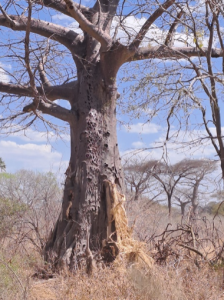 Some trees we saw, you could see right through a hole in the trunk. In all these cases, the baobab has proved quite resilient, and just slowly heals itself and continues to provide what it can – that seems to be the nature of a baobab.
Some trees we saw, you could see right through a hole in the trunk. In all these cases, the baobab has proved quite resilient, and just slowly heals itself and continues to provide what it can – that seems to be the nature of a baobab.
As I thought on these baobabs, loving their different shapes and sizes, I was reminded that we too can be like them. We grow and nurture those around us as needed. Sometimes we are hurt and scarred by those we seek to nurture. Sometimes it is life and its varied circumstances that damage us. Sometimes it’s the death of a loved one that leaves a hole inside of us. And yet, because of the faith we have, we continue to grow and reach out to others. We continue to support, to nurture those around us even when it is difficult. We can go through dry seasons when it seems there is no life in us but then the rain comes. Even a little shower can take the dust off and freshen us up. A good season of rainfall can set us up to continue ministering and serving in the church or community where God has placed us.
I think it’s wonderful how God uses nature to teach us truths about himself or ourselves. Some scriptures to help us reflect on trees are Psalm 1:1-3, Revelation 22:14, Isaiah 61:3, Joel 1:11-12 and the promise in Joel 2:22-25, Jeremiah 17:8, Habakkuk 3:17-18.
As you go about your day, look at the trees around you and thank God for how they nurture you.
Don’t forget we have many Thanksgiving and gratitude resources available. Take some time to explore what we’ve gathered over the years.
by Sue Duby
Some ordinary routines have a way of sending our focus quickly back to Him.
As Chuck backed the car out of the garage, I grabbed the overloaded trashcan to drag it to the curb. A few steps along the way, my foot landed in a puddle of water. My feet flew, my body sailed into the air and I crashed onto the concrete floor. Cautiously, I waited. Curiously, no pain. All limbs intact. Clear vision. I rose easily and continued my journey to the curb.
Chuck looked at me, wide-eyed. “How did you not crack your head, break your wrist and fracture your hip???” I smiled and whispered, “I think an angel cushioned me!”. Not a single bruise the next day! But God.
I rounded the final corner on my walk to find two of Chuck’s buddies chatting. I waved and jokingly called out, “Hope you guys are figuring everything out!” Bob turned my way with a somber look. “I just found out I have a mass in my abdomen”. That wave turned in to a long chat, prayer in the middle of the street and commitment to wait together for news. Two days later, after emergency surgery, we heard. “While I was in recovery, the doctor came by my side and smiled. ‘There is nothing there!!!’”. Somehow, a blood clot had appeared as a mass on the scan, then unexpectedly dissolved just before surgery. Four hours later, Bob was home in his own bed. But God.
A friend showed up for her quarterly exam to check the progression of her macular degeneration. Each time, a scary visit. After more tests, the doctor entered the room and paused. “That’s weird. Your eyes are totally normal. I’ll see you in a year!”. But God.
Matt began experiencing seizures as a teen. One summer day, he convinced his Dad to take him for an afternoon of boating on the lake. Just before leaving the dock, his Dad had one of those unexplainable nudges. “Hey guys. Just in case Matt has an episode in the water, here’s what you need to do”. Less than one hour later, Matt’s arms frantically waved at them, yards from the boat. Clearly a seizure. Everyone jumped, followed protocol and Matt was soon back in the boat, recovering. But God.
I’ve read the wild stories. The ones where no human explanation can be found. The wonders. Always somewhere else. Yet, somehow, I’m realizing, if I pause and pay attention, I can see them too!
So many places in Scripture, He reminds us. But God. The One who does wonders. Who acts on our behalf. Who fulfills His promises. Who invites us to fully trust His ways.
Because the patriarchs were jealous of Joseph, they sold him as a slave into Egypt. But God was with him and rescued him from all his troubles. He gave Joseph wisdom and enabled him to gain the goodwill of Pharaoh king of Egypt. So Pharaoh made him ruler over Egypt and all his palace. Acts 7:9-10 NIV
From human eyes, Joseph’s future looked hopeless. No possible turn of events or way to fix his circumstances. Yet, the story did not end with his slavery. “But God was with him”. . . Just as He is with us. Letting His story unfold in our lives, with the final chapter lovingly in His hands.
Whom have I in heaven but you?
And earth has nothing I desire besides you.
My flesh and my heart may fail,
but God is the strength of my heart
and my portion forever. Ps 73:26 NIV
No matter how much time I spend trying to love like He loves, keep my words kind, not worry about the future and trust His plan for me, it’s not quite enough for that perfect peace. Thankfully, it’s not up to me! “But God is the strength of my heart and my portion forever”.
“What’s the price of two or three pet canaries? Some loose change, right? But God never overlooks a single one. And he pays even greater attention to you, down to the last detail—even numbering the hairs on your head! Luke 12:6-7 MSG
For the myriad of questions and concerns that float through our minds in a day, there is always a P.S. to each of them. “But God _______”. His focus on each of us is sure. His care beyond imagining.
Just think—you don’t need a thing, you’ve got it all! All God’s gifts are right in front of you as you wait expectantly for our Master Jesus to arrive on the scene for the Finale. And not only that, but God himself is right alongside to keep you steady and on track until things are all wrapped up by Jesus. God, who got you started in this spiritual adventure, shares with us the life of his Son and our Master Jesus. He will never give up on you. Never forget that. 1 Cor 1:7-9 MSG
May we fully trust Him in our journeys. Looking for the “But God” stories in our own lives and those around us. Celebrating His goodness when we see them, knowing He is always at work on our behalf.
Here we are in the last week of October. Halloween is in a week and the holidays will be here shortly. This season can be so exhilarating and so draining; it really behooves us to remain constant in our spiritual practices and even to add a little extra to our usual routines. Christine is traveling today, so I’ll take this opportunity to remind you that you can still sign up for all three virtual retreats, even though the first two are done you get recordings of the first two retreats along with the chance to participate in the third. The final retreat in the series is an Advent Quiet Day on December 9th; you can also register for that retreat alone.
The next week and a half includes All Saints Sunday, All Saints’ Day or Day of the Dead and Halloween. If you’re looking for a practice to make Halloween a more sustainable and green holiday, Christine shared a Halloween practice last week. As we look towards (American) Thanksgiving in about a month, I encourage you to look into the Thanksgiving resources we have compiled over the years.
This week in her Meditation Monday – Life Giving or Life Draining? Christine reflected on discerning what we should say yes to and what we should reject as we enter this upcoming gratitude and Advent Season. I recommend it as a starting place for your own reflections about what sustains you – during the holidays or regular days.
As someone who grew up in Washington state, one of the main apple growing regions of the United States, I was very interested to read Carol Dixon’s post for Apple Day. It reflected on apples from biblical times to recent festivals in England and encouraged me to think about the amazing blessings that are sometimes just sitting on our kitchen counters.
Lilly Lewin followed on a theme last week, gratitude and grief in her
FreeRangeFriday: Gratitude and Grief Practices post. In life, and especially in this time of harvest and of war, it is so important to have practices for both grief and gratitude. Jean Adrianoff shared a particular gratitude practice using photographs in her post A Practical Way to Share the Wonder while The Rev. Elaine Breckenridge encouraged us to share her encounters with woods through poetry, art, and reflection in her post In the Heart of the Forest.
May you have a blessed week,
Melissa for Godspace
Don’t forget we have many Thanksgiving and gratitude resources available. Take some time to explore what we’ve gathered over the years.
by Christine Sine
You probably realize by now that I love to mess with traditions and reshape liturgical practices and seasons to better fit my own state of mind and the issues I am grappling with. As the war in Israel/Palestine rages on, I find my gratitude season has become instead a season of grief and gratitude. I blogged about that last week, but today realized there is another aspect of this that I wanted to share.
This week my focus revolved around the question “What is life gaining and what is life draining at the moment ?
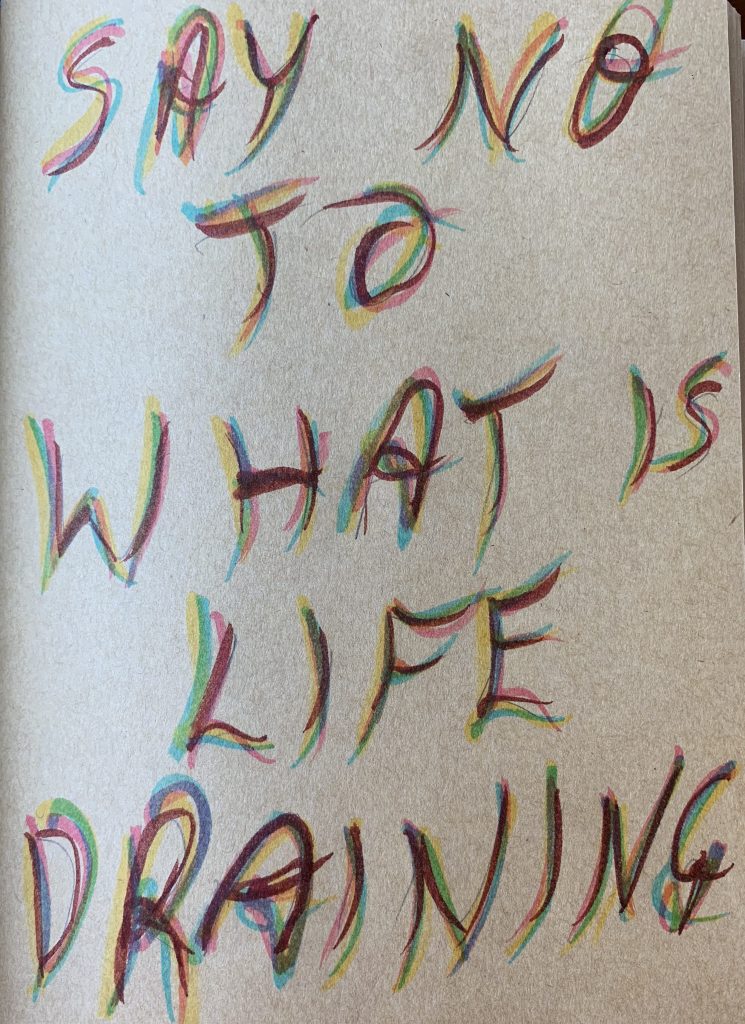
I wrote “say no to what is life draining” then began to list what came to mind.
- Turn my back on negative thinking about what I am doing, the future, the world around me. That only leads to despair and depression.
- Say no to Christmas shopping. I find it overwhelming and very draining to do Christmas shopping in the weeks before Christmas. Even the steady stream of ads and hyped up incentives to buy more that flood my inbox leave me feeling exhausted. So during November I will try to keep this exposure to a minimum.
- Switch off the news. Watching too much news about the wars in Ukraine and Israel/Palestine, climate change, political upheaval and polarization, refugee crises, and hurricanes devastation overwhelms and drains me leaving me feeling inadequate and useless. Switching off the news doesn’t mean I don’t take notice of it, but it does mean I don’t allow it to control my life.
- Say no to too much food and “Christmas cheer”. The guilt that goes with over eating and over consuming is not only draining but actually makes me want to eat more and it seems to begin earlier every year, usually as the cold weather sets in. Now is the time to choose which gatherings are life gaining and which are life draining and say no to the ones I don’t really want to go to anyway. One of our favourite gatherings over the Advent season is going to the Messiah and we have already booked our tickets for that.
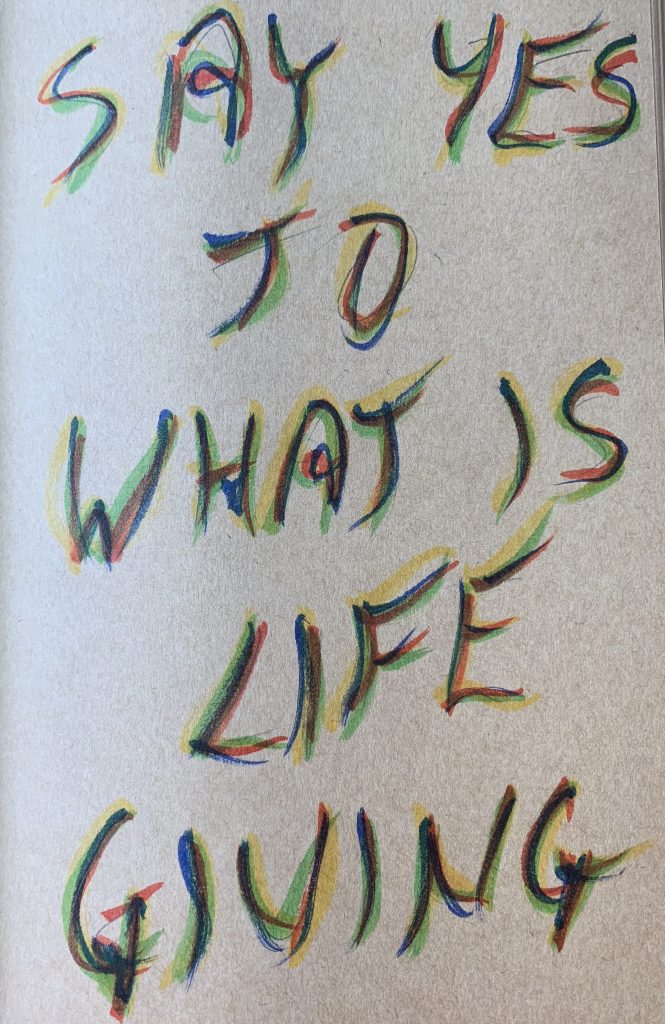 Then I started to think about what is life gaining for me. Part of what I realized is that there are solutions to my life draining challenging that are actually life gaining.
Then I started to think about what is life gaining for me. Part of what I realized is that there are solutions to my life draining challenging that are actually life gaining.
- Negative thinking can become hope and promise if I focus on where I see God’s love and joy breaking through – Instead of saying “I can’t do this” I can say “This is hard but I can persevere.” Or I can say “in the midst of this difficult challenge I am grateful for friends and family that support me.” We can also do what my friend Sue Duby taught me to do – look for the joy spots. Instead of asking “Why did God let this happen?” ask “Where is God already at work in the situation that drains me? How can I join in? “
What could you do to focus away from negative thoughts onto the positive?
- Transform crises into opportunities for generosity. Watching the news about the devastation of the wars and earthquakes, floods and droughts as well as speaking to friends who work with refugees, the homeless and those at the margins of society spurs me to be generous with my giving and my volunteering over the next few months.
How could you respond to the crises in the world around you? Is God prompting you to be more generous to others with your time or resources?
- Plan for shows that are life giving. Over the last few months Tom and I have found an array of wonderful programs on Netflix and Britbox that are very life gaining for us – stories about creativity about animals and the natural wonders of our world. Stories about families that care for each other and their neighbours. It has transformed our TV and live-streaming focus. Thinking about the “shows” that are life gaining for me spurs me on to plan our Advent and Christmas watching in advance – Messiah, Advent carols, Advent retreat. There are wonderful life gaining alternatives.
What entertainment over the next couple of months would be life giving for you? How could you say no to those that are not?
- Plan parties that are life giving. By now you probably realize that I love to plan parties and the Advent season is one of my favorites to get ready for. Since COVID we no longer hold big gatherings in our house, but I still do lots of cooking for friends and family across the country. Next week I will pull out my copy of The Godspacelight Community Cookbook to get some new ideas. I will soak fruit for the English style Christmas cake that is always so popular. (yep it needs to soak for a month before I make the cake) I might even get my first batch of Scottish shortbread though of course that can encourage me to start overeating early. Cooking at this seasons, knowing that I will share in with others is very life-giving for me.
Planing parties and cooking may not be life giving for you, but what are the ways that you like to bless others? What are the sharing activities you love to participate in or plan for over the Thanksgiving/Advent and Christmas season?
- Plan for a zero waste DIY Christmas. What if I aim at a zero waste Christmas this year? Making Christmas gifts is life gaining for me. What about a totally home made gift Christmas this year? It’s time to pull out the knitting needles and maybe make some of those photo albums Jean Andrianoff talked about in her post A Practical Way to Share the Wonder Not only is that a fun and life gaining thought, it is also an inspiring and joy filled one.
Maybe homemade gifts doesn’t appeal to you but how could you reduce the stress of Christmas gift giving this year?
- Create spiritual practices that are life gaining. My focus on gratitude is just one of the spiritual practices I plan to use in the coming months. I hope to paint leaves, and pine cones at our community meal – a wonderful beginning to the season and something that helps all of us slow down, reflect and relax. Meditation gardens are part of my delight at this season too, becoming more and more a part of how I love to prepare for a new season. I plan to refresh my memory by rereading the section in Digging Deeper: The Art of Contemplative Gardening on how to create a contemplative garden and will then get to work on an Advent garden which I plan to create before the beginning of Celtic Advent on November 15th. Other practices enrich the season for me too. The Advent Quiet Day retreat is something that I find I value as much for myself as for the enrichment of others. -I will also start to add Advent images to use as I redecorate my sacred space for Celtic Advent.
What are the practices that are life giving for you over the Thanksgiving/Advent and Christmas seasons? How can you make sure that you protect these practices?
The upcoming seasons of Thanksgiving and Advent are meant to be joyous and celebrate. Prayerfully consider ways that you could make this more of a focus in the coming month… and maybe you could join us for our retreat December 9th as a start .
NOTE: As an Amazon Associate I receive a small amount for purchases made through the links above. Thank you for supporting Godspacelight in this way.
by Carol Dixon
An apple a day . . . . . . keeps the doctor away is a common saying that comes from an old English adage, ‘to eat an apple before going to bed, will make the doctor beg his bread’.
The apple dates from Biblical times and, depending on the Bible translation, it is referred to several times. It is often thought to have been the forbidden fruit that Adam and Eve picked from the Tree of Life, although most Biblical scholars will tell you that the fig is a more likely candidate, especially as they covered their nakedness with fig leaves. According to Christiananswers.com ‘There is currently no clear evidence that apples grew in Israel in ancient times (possibly due to the heat). But they were certainly not unknown in Israel, and the land does have cooler hill country. They grew north of Israel in Lebanon and the ancient Romans cultivated apple trees extensively. It is also possible that climatic conditions may have been more favourable in ancient times in Israel. Today, more than 40 types of fruit are commercially grown there in the northern hills of Israel and in Gaza. The apple is thought to have been domesticated 4,000–10,000 years ago in the Tian Shan mountains between western China, Kyrgyzstan and Kazakhstan. It then travelled along the Silk Road to Europe, with hybridization and the transfer of generic material between species of wild crab apple from Siberia, the Caucasus and Europe. The earliest known named English apple variety is the pearmain which was first mentioned in 1204, having been introduced into Britain by the Normans.
In 1990, Common Ground, a Dorset charity, decided it was time to boost the social standing of the humble British apple by giving it a special celebration day, aptly called ‘Apple Day’ to be held on 21 October each year. Apple Day was intended to raise the awareness of the danger of not only losing the traditional British apple but to also highlight the richness and diversity of our landscape, ecology, and culture. It has, says Common Ground, also played a part in raising awareness in the provenance and traceability of food.
Common Ground describes themselves as ‘a small, grass roots organisation that collaborate openly to reconnect people with nature and inspire communities to become responsible for their local environment.’ They believe that enjoying where you live and celebrating the connections people have with the wildlife and landscape on their doorstep, is at the root of meaningful conservation.
Raising awareness of the British apple is an excellent example of their ambitions. Did you know, for example, there are about 2,500 varieties of apples in the UK alone — worldwide the number is about 7,000. It has been calculated that you could eat a different variety of English apple every day for six years, so why not start by trying some different varieties on Apple Day this month.
The success of Apple Day has shown what the apple means to us and how much we need local celebrations in which, year after year, everyone can be involved. In city, town and country, Apple Day events have fostered local pride, celebrated and deepened interest in local distinctiveness. We would still like Apple Day to become the autumn holiday in Britain. Apple Day is now an integral part of the calendar of many villages, local authorities and city markets. It is a focus for activities organised by the Women’s Institute, National Trust properties, Wildlife Trusts, museums and galleries, horticultural societies, shops and restaurants as well as for schools, colleges and environmental study centres. The first Apple Day celebrations, in the old Apple Market in London’s Covent Garden, brought fruit to the market after 16 years’ absence. Forty stalls were taken. Fruit growers and nurseries producing and selling a wide variety of apples and trees rubbed shoulders with juice-and cider-makers, as well as writers and illustrators with their apple books.
We will never know just how many people came to that first celebration – it was certainly thousands and even now we meet people who effuse about it as a memorable event. Many wanted it to be repeated, but our intention was to spread the idea far and wide, encouraging people to celebrate Apple Day for themselves in their own city, village, parish, allotment or garden orchard.
And so the tradition of Apple Day began. Over the next few years, the number of events being organised around the country grew from more than 60 in 1991 to 300 by 1997 and over 600 in 1999, some attracting thousands of people. Apple Day has played a part in raising awareness not only of the importance of orchards to our landscape and culture, but also in the provenance and traceability of food. It has been one impetus behind the developing network of farmers’ markets and is helping people everywhere to discover they are not alone in valuing the links between food and the land, between natural resource use and the impact we have on nature.
We have used the apple as a symbol of what is being lost in many aspects of our lives and shown that anyone can take positive action towards change. Over the years, Apple Day has been celebrated in a wonderful variety of ways by a diverse range of people. Doctors’ surgeries, coronary support groups, and the Cancer Research Campaign have taken Apple Day as a novel way of encouraging healthy eating. Each year, alongside tasting, juicing, baking, pruning and grafting, an imaginative array of games and creative activities have flourished – ranging from simple apple printing to mummers’ apple plays, new songs and poetry evenings. But invariably, year after year, the most popular event is the display, tasting and buying of numerous varieties of apples and the presence of an expert to aid identification.
The 18th century English mystical poem ‘Jesus Christ the apple tree’ by an unknown writer uses the analogy of Jesus as the tree of life that is even more wonderful than the wonder of apple trees.
https://youtu.be/XYNNVLKuyJg?feature=shared
The tree of life my soul hath seen
Laden with fruit, and always green:
The trees of nature fruitless be
Compared with Christ the apple tree
His beauty doth all things excel:
By faith I know, but ne’er can tell
The glory which I now can see
In Jesus Christ the apple tree
For happiness I long have sought
And pleasure dearly I have bought:
I missed of all; but now I see
‘Tis found in Christ the apple tree
I’m weary with my former toil
Here I will sit and rest awhile:
Under the shadow I will be
Of Jesus Christ the apple tree
This fruit doth make my soul to thrive
It keeps my dying faith alive;
Which makes my soul in haste to be
With Jesus Christ the apple tree
Based on an article in St James’s URC, Alnwick church magazine (used with permission)
To learn more about Common Ground see https://www.commonground.org.uk
Today I am very grateful to be in Minneapolis with my prayer group…we haven’t seen each other in real life in over five years! We are celebrating friendship and God’s faithfulness and laughing a lot! We all met through working for youth specialities and the National Youth Workers Convention.
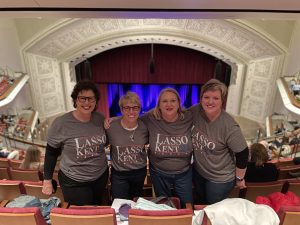
It’s a season of gratitude and grief…I honestly have been speechless over the violence and death in the middle east again this week. My heart is broken for all those who are suffering. I pray daily for peace and for the peacemakers. I hate war. and I Hate destruction and death! I hate war.
Ive been thinking about all the waste!
Waste of people, resources, housing. Things will never be the same.
The places will never be the same.
The communities will never be the same. Families never the same.
War is destruction of beauty .
And all in the name of power and hate& revenge.
And someone is making money off of all the waste, destruction and death.
I follow the prince of peace who said,
” blessed are the peace makers”
And love your enemies and pray for those who persecute you. VERY HARD THINGS TO DO! But so needed in our world.
There is a sign on a church near me that says, “It’s Ok Not to be OK.” I feel a bit like Habakkuk raising my fist in the air to God, asking “HOW LONG?”
2 How long, Lord, must I call for help,
but you do not listen?
Or cry out to you, “Violence!”
but you do not save?
3 Why do you make me look at injustice?
Why do you tolerate wrongdoing?
Destruction and violence are before me;
there is strife, and conflict abounds. Habukkuk 1:1-3
I keep reminding myself of what Father Micheal Sparough says…START WITH GRATITUDE when you pray.
It’s why the prayer of Examen begins with gratitude…when we start with being grateful we see how wonderful, and wonder-filled life is even in the midst of all the loss and craziness. Try the Prayer of Examen led by Father Sparough.
It’s a season of Gratitude! We need to get out the GRATITUDE JAR and be reminded of all the things that are good in our worlds. You can download a kit for FREE Here. Each day, you pull out a word or phrase and take time to be grateful for it. Some things are harder so you have to ask Jesus for help and for eyes to see how to be thankful for them.
We have another practice of creating a GRATEFULNESS/THANKFUL window using post it notes. You can buy colorful post it notes and create a stained glass window using them and a pen or sharpie to write down things your are thankful for each day! All ages can play and participate and even if you are living solo, you can create a Grateful/Thankful Window!
I also got out the jars I use for my Advent candles which are labeled with HOPE AND PEACE and put a small globe near the candles to remind me to pray for peace for all the world!
LISTEN: I discovered Jon Guerra’s music this week…It is giving me hope! And Porters Gate’s music helped me survive the pandemic. They have an entire album on Lament. Make a Grateful Playlist and listen to it on REPEAT!
Habakkuk begins with his fist raised and he ends the book with
The Sovereign Lord is my strength;
he makes my feet like the feet of a deer,
he enables me to tread on the heights. Habakkuk 3:1
Pray with me:
Today, I am taking time to pray for peace & peacemakers. Help us Jesus!
Today, I am taking time to be grateful for life and watching for things that bring hope!
Give me eyes to see!
In a world filled with destruction and despair, today I want to bring light and love and joy and hope.
Lord with your help!
Amen
As an Amazon Associate, I receive a small amount for purchases made through appropriate links.
Thank you for supporting Godspace in this way.
When referencing or quoting Godspace Light, please be sure to include the Author (Christine Sine unless otherwise noted), the Title of the article or resource, the Source link where appropriate, and ©Godspacelight.com. Thank you!

